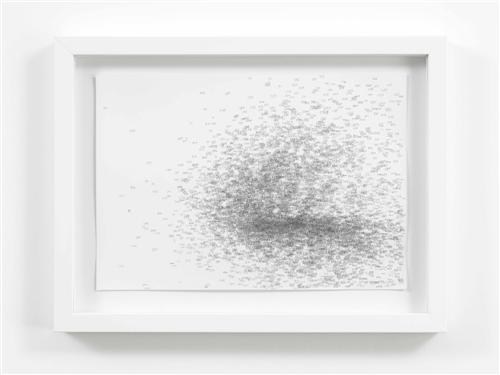
I
was visiting Carmit when she lived in Preston, UK. While she worked during the day, I
wandered around Preston which has a museum/art gallery.
There I saw Nick Kennedy's "Dice Drawings". (If you google Nick Kennedy Dice Drawings, you can see a lot of different works).
His premise is to decide on the medium, rules of engagement, and let
dice dictate placement and use of media. Long story long, his medium is paper and pencil.
He made an "x" in the middle of the page, rolled a die trying to hit the
"X", and where the di landed, he used a manual counter to record in blue pencil the number appearing on the counter. If he hit the same number twice in a row, he switched to a red pencil. After many rolls of the
die, and switching pencil colour, he reached the number on the counter which he had set as his goal. The result: Dice Drawings.
It looks like a swarm of bees but a closer look reveals the marks are the numbers appearing on the counter.

When
I got home, I kept thinking about how I could use the premise - i.e.
leaving the placement of stitches up to chance. After contacting Nick
and obtaining his permission to steal borrow his idea, I thought hmmm, how can I do this in textiles?
My rules of engagement were:
1, to use fabric on hand.
2. to give the piece Judaic content.
3. to break the rules if necessary, me being the arbiter of necessity...
For fabric on hand, I had leftover dupionni silk from other projects in many colours.
For
Judaic content, I thought "chai". If I make the piece an 18" square,
that's chai. If I made the piece from 36 dupionni squares, chai again.
And if I use 3 dice, yet again chai.
How
to choose the fabric colours and placement? I didn't have 36 different
colours but I did have over 18. So I made a grid of 6 blocks across
and 6 blocks down and identified each A1-6, B1-6, etc.
If I used 18 fabrics, I could use each colour twice, the first in A-B-C
1-6, the second in D-E-F 1-6. I hope you're getting the visual. Just
imagine each cell is 3" square (because I haven't figured out yet how to
make the table yet.
OK. So now how do I decide on placement? By casting lots, obviously. A Jewish tradition going back to the Torah. See
Leviticus 16:8. So I put fabrics squares for A-C in a bag, and slips
of paper numbered A-1, A-2, etc. into a separate bag. I pulled a square
from the fabrics bag and a slip of paper from the papers bag and
voila. The colour and its placement on the grid. The process was
repeated for D-F. So if I pulled out, for example, a blue fabric square
and a paper slip marked A-3, the blue square would go into A-3 on the
grid. And so on until the entire grid was filled.
But
could I leave it alone? No. I broke the rules by deciding that I
could roll the die once for each half of the grid. The number on the
face of the die would dictate how many squares I could move around and
reposition, up to a maximum of 6. My luck, it fell on 1 on each roll.
So
that takes care of the placement of fabrics. I sewed them into rows
and then joined the rows together in numerical order. However, I wanted
to bead the squares. New Rules!
I
was going to bead 18 chai squares. To determine which squares to bead,
I rolled two dice, I one marked A - F, and the other with the regular 1
- 6 dots.
Then to determine how many beads to bead at each location, I rolled 3 regular dice (maximum of 18 beads per square).
(Sorry,
haven't figured out how to rotate photo yet...) But you get the idea, I
hope. I had two rolls for placement which were duplicates so I had to
roll again.
I got to choose the type of bead and how to bead on each square. The
almost finished pieces was not quite 18" - it needed borders. So I
left the final decision of whether to do a border of one colour the
entire perimeter or one colour on each side up to the member of the
Pomegranate Guild. They chose one colour for the entire border.
And this is the finished piece, not the best photography but a future challenge.
What
I learned: a new for me word "aleatoricism" which is defined as the
incorporation of chance into the process of creation, especially art or
media, from Latin "alea", the rolling of dice.
Still contemplating a series of 6 X 3, 2 X9... or perhaps I could use fabric
instead of paper and make a mark with a pen and then cover it with an
embroider stitch. Or use silk and permanent markers and rubbing
alcohol, or...






































